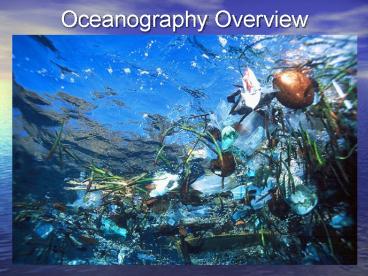Oceanography Overview PowerPoint PPT Presentation
1 / 17
Title: Oceanography Overview
1
Oceanography Overview
2
1. Oceanography Polar Views of the Earth71 of
Earth is covered with oceans
3
Land-Ocean DistributionWhich latitudes have the
most land? Which latitudes have the least land?
4
2. Seawater Properties
- Salinity
- Measure of dissolved salts in water
- Grams dissolved per 1000 grams water
- Average salinity is 35 grams of salt per 1000
grams of water - 35
- In comparison.(parts per thousand)
- Distilled Water 0
- Lake Erie 2-3
- Ocean 35
- Great Salt Lake 45
- Dead Sea 250
5
Dissolved elements in Ocean Water
Chloride and Sodium are the 2 main elements
dissolved in ocean water
6
3. Sunlight penetration
The blue spectrum of sunlight travels the best in
water, therefore the oceans look blue.
The top layer of the ocean is warmer due to the
penetration of sunlight. The amount of sunlight
that penetrates the ocean affects life in the
ocean zones.
7
3. Temperature V/S Depth
The thermocline is the layer in the ocean where
the temperature dramatically decreases. It
separates the mixed layer at the top from cold
deep layer below. Remember Convection currents
help transfer heat in our oceans!
Mixed layer
Thermocline
Deep layer
8
4. Ocean currents
- Ocean currents exist at many levels in the ocean
- surface currents, mid-level currents, and deep
sea currents. - Ocean currents help circulate the Suns heat and
important nutrients for ocean life.
9
5. Upwelling occurs when cold, nutrient rich
water rises to replace the warmer, nutrient
depleted water.Because cold water is more dense,
upwelling is driven by the wind. It pushes the
warm water out of the way, so the cold water can
rise.
- Upwelling is important for the fishing industry
because it allows nutrients (food) to rise for
the fish to eat and grow.
10
(No Transcript)
11
El Nino Conditions causeLoss of
fish/fishingWarmer surface waterIncrease in
storms (warmer water more evaporation)
12
6. Coral reefs
- Coral reefs are underwater structures of calcium
carbonate made by corals (living organisms) - Ancient coral reefs may have formed the present
day limestone - The great barrier reef in Australia is the
largest living structure on Earth
They are endangered and sensitive. They can be
destroyed by temperature changes, pollution, and
by being hit/struck.
13
Formation of a coral atoll
- Coral atolls form from sunken volcanic islands
- They are just one type of coral reef
- The enclosed water is called a lagoon.
14
Most Corals only survive in shallow, warm water
79-81F. Coral Bleaching occurs when the corals
die. The colors fade away, but the calcium
carbonate shell remains.
15
(No Transcript)
16
(No Transcript)
17
(No Transcript)

